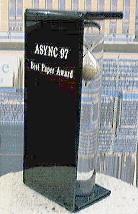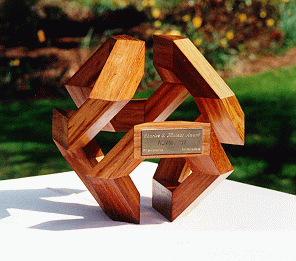The `best paper' at Async97
was selected from the accepted papers by popular vote of the participants.
Here are the top three papers (84 valid votes were received):
- Async97 Best Paper: (13 votes)
AMULET2e: An Asynchronous Embedded Controller
S.B. Furber, J.D. Garside, S.Temple, J. Liu,
University of Manchester, UK
P. Day, N.C. Paver, Cogency Technology, UK
- (11 votes)
A FIFO Ring Oscillator Performance Experiment
Charles E. Molnar, Ian W. Jones, Bill Coates, Jon Lexau,
Sun Microsystems Laboratories, USA
- (9 votes)
The Design and Verification of a High-Performance
Low-Control-Overhead Asynchronous Differential Equation Solver
Kenneth Y. Yun, Ayoob E. Dooply, Julio Arceo,
University of California, San Diego, USA
Peter A. Beerel, Vida Vakilotojar, University of Southern
California, Los Angeles, USA
(9 votes)
A Low-Power Zero-Overhead Self-Timed Division and Square Root Unit,
Combining a Single-Rail Static Circuit with a Dual-Rail Dynamic Circuit
Gensoh Matsubara, Nobuhiro Ide, Toshiba Corporation, Japan
 The Async97 Best Paper Award
(picture, provided by Steve Furber)
is called AquaMagic - Double.
It consists of two transparent tubes
(only one of which is visible in the picture)
mounted in parallel and filled with a clear liquid.
Each of the tubes holds an hourglass,
one sitting at the bottom, the other floating at the top.
When the device is turned upside down, the hourglasses do not move
with respect to the liquid, and the sand starts running.
After a while, the hourglass at the bottom slowly rises to the top, and
the hourglass at the top slowly sinks to the bottom.
How come?
It provides a nice example of a counterflow pipeline.
Ray Bathke
from Village Games constructs
AquaMagic Hourglasses, either in single or in double format.
In the summer of 1996,
Charlie Molnar
(Sun Microsystems Laboratories)
proposed the idea of having a special award at Async97
for the contribution that best bridges the gap
between theory and practice.
It would be an award sponsored by both
Sun Microsystems Laboratories
(Mountain View, California, USA) and
Philips Research Laboratories
(Eindhoven, The Netherlands),
to emphasize the special relationship of these two industrial research
labs and Eindhoven University of Technology.
This idea was immediately embraced by all parties involved.
The issue of finding an appropriate name for this award had been postponed.
After December 13, 1996, when
Charlie Molnar
suddenly passed away,
there was no doubt in our minds that we should name it the
Charles E. Molnar Award.
A specially established committee has carefully selected
the recipient of the award from a shortlist prepared by the organization.
This committee consisted of
The Async97 Best Paper Award
(picture, provided by Steve Furber)
is called AquaMagic - Double.
It consists of two transparent tubes
(only one of which is visible in the picture)
mounted in parallel and filled with a clear liquid.
Each of the tubes holds an hourglass,
one sitting at the bottom, the other floating at the top.
When the device is turned upside down, the hourglasses do not move
with respect to the liquid, and the sand starts running.
After a while, the hourglass at the bottom slowly rises to the top, and
the hourglass at the top slowly sinks to the bottom.
How come?
It provides a nice example of a counterflow pipeline.
Ray Bathke
from Village Games constructs
AquaMagic Hourglasses, either in single or in double format.
In the summer of 1996,
Charlie Molnar
(Sun Microsystems Laboratories)
proposed the idea of having a special award at Async97
for the contribution that best bridges the gap
between theory and practice.
It would be an award sponsored by both
Sun Microsystems Laboratories
(Mountain View, California, USA) and
Philips Research Laboratories
(Eindhoven, The Netherlands),
to emphasize the special relationship of these two industrial research
labs and Eindhoven University of Technology.
This idea was immediately embraced by all parties involved.
The issue of finding an appropriate name for this award had been postponed.
After December 13, 1996, when
Charlie Molnar
suddenly passed away,
there was no doubt in our minds that we should name it the
Charles E. Molnar Award.
A specially established committee has carefully selected
the recipient of the award from a shortlist prepared by the organization.
This committee consisted of
- Kees van Berkel, Philips Research Laboratories, Eindhoven, The Netherlands
- John Brzozowski, University of Waterloo, Ontario, Canada
- Ian Jones, Sun Microsystems Laboratories, Mountain View, California, USA
- Takashi Nanya, Tokyo Institute of Technology, Tokyo, Japan
- Jens Sparsø, Technical University of Denmark, Lynby, Denmark
The committee had a difficult task and met three times during the conference
for deliberation.
The committee chose to present the Charles E. Molnar Award to
two papers for their combined contributions. These two papers
report the work of two closely collaborating research teams.
The first paper, by Xie and Beerel, develops and extends
mathematical techniques for performance analysis. The second, by
Yun, Beerel, Vakilotojar, Dooply, and Arceo exploits methods
of the first paper in a nontrivial VLSI design. The two
collaborating teams have applied new and existing design tools
to a well-focused task. In Charlie Molnar's words, they employed
"the ultimate verification method of fabricating and testing real
circuits". It is for this outstanding achievement combining
theory and practice that the award is being presented.
The Charles E. Molnar Award goes to two papers:
- Symbolic Techniques for Performance Analysis of Timed Systems
based on Average Time Separation of Events
Aiguo Xie, Peter A. Beerel,
University of Southern California, Los Angeles, USA
- The Design and Verification of a High-Performance
Low-Control-Overhead Asynchronous Differential Equation Solver
Kenneth Y. Yun, Ayoob E. Dooply, Julio Arceo,
University of California, San Diego, USA
Peter A. Beerel, Vida Vakilotojar,
University of Southern California, Los Angeles, USA
The Charles E. Molnar Award consists of a check of 1,000.- ECU and a trophy.
The award was presented by Donna Molnar, the wife of the late Charlie Molnar.
 The trophy is made of iroko, a beautiful African hardwood.
On first impression it looks like a contorted beam doing a three-dimensional
dance.
Closer inspection shows that the trophy exhibits many symmetries
and might even reveal that the beam traverses a Hamiltonian cycle
on the edges of a truncated octahedron
(a closed path visiting all 24 vertices exactly once).
The beam is made from 24 identical pieces
having a rectangular cross section, such that
cutting the beam at 45 degrees yields a square face.
With these 24 pieces more than 62,000 closed 3D-space walks are possible.
The trophy was designed and constructed by mathematician Koos Verhoeff,
professor emeritus in computing science at the Erasmus University in
Rotterdam, The Netherlands.
Koos was an acquaintance of Charlie Molnar and occupies himself
with mathematical art since his retirement.
The accompanying picture was taken by Kim Verhoeff.
The trophy is made of iroko, a beautiful African hardwood.
On first impression it looks like a contorted beam doing a three-dimensional
dance.
Closer inspection shows that the trophy exhibits many symmetries
and might even reveal that the beam traverses a Hamiltonian cycle
on the edges of a truncated octahedron
(a closed path visiting all 24 vertices exactly once).
The beam is made from 24 identical pieces
having a rectangular cross section, such that
cutting the beam at 45 degrees yields a square face.
With these 24 pieces more than 62,000 closed 3D-space walks are possible.
The trophy was designed and constructed by mathematician Koos Verhoeff,
professor emeritus in computing science at the Erasmus University in
Rotterdam, The Netherlands.
Koos was an acquaintance of Charlie Molnar and occupies himself
with mathematical art since his retirement.
The accompanying picture was taken by Kim Verhoeff.
 The Async97 Best Paper Award
(picture, provided by Steve Furber)
is called AquaMagic - Double.
It consists of two transparent tubes
(only one of which is visible in the picture)
mounted in parallel and filled with a clear liquid.
Each of the tubes holds an hourglass,
one sitting at the bottom, the other floating at the top.
When the device is turned upside down, the hourglasses do not move
with respect to the liquid, and the sand starts running.
After a while, the hourglass at the bottom slowly rises to the top, and
the hourglass at the top slowly sinks to the bottom.
How come?
It provides a nice example of a counterflow pipeline.
Ray Bathke
from Village Games constructs
AquaMagic Hourglasses, either in single or in double format.
The Async97 Best Paper Award
(picture, provided by Steve Furber)
is called AquaMagic - Double.
It consists of two transparent tubes
(only one of which is visible in the picture)
mounted in parallel and filled with a clear liquid.
Each of the tubes holds an hourglass,
one sitting at the bottom, the other floating at the top.
When the device is turned upside down, the hourglasses do not move
with respect to the liquid, and the sand starts running.
After a while, the hourglass at the bottom slowly rises to the top, and
the hourglass at the top slowly sinks to the bottom.
How come?
It provides a nice example of a counterflow pipeline.
Ray Bathke
from Village Games constructs
AquaMagic Hourglasses, either in single or in double format.
 The trophy is made of iroko, a beautiful African hardwood.
On first impression it looks like a contorted beam doing a three-dimensional
dance.
Closer inspection shows that the trophy exhibits many symmetries
and might even reveal that the beam traverses a Hamiltonian cycle
on the edges of a truncated octahedron
(a closed path visiting all 24 vertices exactly once).
The beam is made from 24 identical pieces
having a rectangular cross section, such that
cutting the beam at 45 degrees yields a square face.
With these 24 pieces more than 62,000 closed 3D-space walks are possible.
The trophy was designed and constructed by mathematician Koos Verhoeff,
professor emeritus in computing science at the Erasmus University in
Rotterdam, The Netherlands.
Koos was an acquaintance of Charlie Molnar and occupies himself
with mathematical art since his retirement.
The accompanying picture was taken by Kim Verhoeff.
The trophy is made of iroko, a beautiful African hardwood.
On first impression it looks like a contorted beam doing a three-dimensional
dance.
Closer inspection shows that the trophy exhibits many symmetries
and might even reveal that the beam traverses a Hamiltonian cycle
on the edges of a truncated octahedron
(a closed path visiting all 24 vertices exactly once).
The beam is made from 24 identical pieces
having a rectangular cross section, such that
cutting the beam at 45 degrees yields a square face.
With these 24 pieces more than 62,000 closed 3D-space walks are possible.
The trophy was designed and constructed by mathematician Koos Verhoeff,
professor emeritus in computing science at the Erasmus University in
Rotterdam, The Netherlands.
Koos was an acquaintance of Charlie Molnar and occupies himself
with mathematical art since his retirement.
The accompanying picture was taken by Kim Verhoeff.